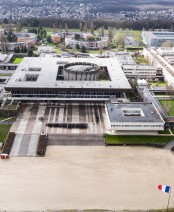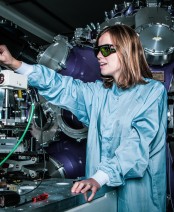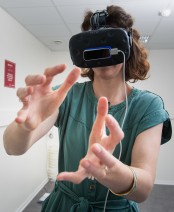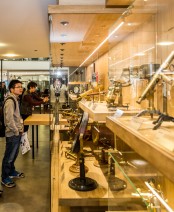An ERC grant to understand the first moments of the Universe


Quantum chromodynamics (QCD) is a physical theory that describes the strong interaction, one of the three fundamental forces of the Standard Model of Particle Physics. It seeks to describe the interactions between quarks and gluons, elementary particles that make up atomic nuclei.
Understanding these interactions within nuclei is precisely the objective of Leticia Cunqueiro, a Spanish physicist who will soon join the heavy ion physics team at the Leprince-Ringuet Laboratory (LLR*). She has been awarded a Consolidator grant from the European Research Council (ERC) to enable her to implement her "QCDHighDensityCMS" project.
Heavy ion physics
Heavy ion collisions are the only laboratories on earth where QCD can be studied at high temperatures. Heavy atomic nuclei are smashed in particle colliders and produce a strongly coupled quark-gluon plasma, which behaves according to experimental evidence as an almost perfect liquid.
A classical plasma is a state of matter in which electrons separate from atoms and form a "soup" of highly agitated electrons and ions that can emit light. A lightning bolt, the aurora borealis, or the sun are plasmas.
Studying the plasma of quarks and gluons resulting from the collision of heavy ions is of considerable scientific interest: it describes the state of the matter of the universe a few microseconds after the Big-Bang. This state in which elements are strongly correlated also appears in other fields of physics, notably in condensed matter, cold atoms and black hole physics.
But contrary to classical plasmas which can be observed by different methods, techniques to probe quark-gluon plasmas are trickier. Thanks to her experience with colliders and the jets of particles that are emitted by collisions, Leticia Cunqueiro proposes an original method which bring in unique opportunities and open up new windows in the quantification of the microscopic properties of the plasma
Probe plasmas with particle jets
After studying in theory and then experimentally the collisions between two protons at CERN, Leticia has acquired a solid expertise in particle jets that can be traced back to the quarks released by these impacts. Indeed, the particles resulting from these collisions are not directly visible because they cannot "live" freely in nature.
The quarks will therefore rapidly “dress” themselves by irradiating gluons and will produce a cascade of particles, a process called a “jet”. By capturing a large part of the particles created, and recalculating the reverse process with complex algorithms, researchers are then able to find the energy and direction of the initial quark.
Leticia Cunqueiro's objective with her QCDHighDensityCMS project is to answer several questions (see box below) about quark-gluon plasmas by using the jets produced by the collisions as a probe for the plasma.
The researcher draws a parallel with Rutherford's famous experiment. Carried out more than a century ago, this experiment revealed the structure of the atom by bombarding a gold leaf with helium nuclei (alpha particles). Thus, by the rebounds and deflections of the particles used as probes in the Rutherford experiment, it was possible to determine that the atoms are essentially composed of vacuum, with the positive charges grouped in a nucleus in the center.
Today, by using the jets and their internal structure by the collisions to probe the quark-gluon plasma, Leticia aims to better understand the forces that govern the components of these nuclei.
Understanding the infinitely small with colossal instruments
For her research, Leticia Cunqueiro will join the research team led by Matthew Nguyen at the LLR and will work on the CMS experiment, a 21-meter long, 15-meter diameter cylindrical detector located on the Large Hadron Collider (LHC) at CERN (Geneva). Her research is in line with the strategy of the LLR and the National Institute for Nuclear and Particle Physics (IN2P3). Her project thus illustrates IN2P3 baseline, "Probing the two infinites", because by probing the infinitely small, Leticia Cunqueiro’s project aims to understand the forces at work in our universe at its beginning.
About Leticia Cunqueiro
Leticia Cunqueiro is a physicist at Oak Ridge National Laboratory (USA). She did her PhD in Particle Physics in the University of Santiago de Compostela, 2008. Before landing in ORNL, she worked for the Italian National Institute of Nuclear Physics as a postdoctoral fellow and as associate researcher, as a research fellow at CERN and as a postdoctoral researcher in Muenster University, Germany. Until she joins Polytechnique, she works on jet physics in ALICE experiment at CERN and serves as deputy physics coordinator.
About the ERC Consolidator Fellowships
The ERC Consolidator Grant distinguishes researchers with 7 to 12 years of experience after their PhD with an ambitious project based on high-level scientific research with an exploratory dimension.
To go further:
Some of the questions that Leticia Cunqueiro intends to solve during her project:
- Can we find free quarks and gluons in the strongly coupled quark-gluon plasma?
- Will it be possible to directly measure - for the first time - quantum interference effects such as color coherence, or the "dead cone effect” in heavy ion collisions?
- What is the role of time? Can we extract a notion of time from splitting kinematics?
*LLR, a joint research unit CNRS-IN2P3 / École polytechnique - Institut Polytechnique de Paris








